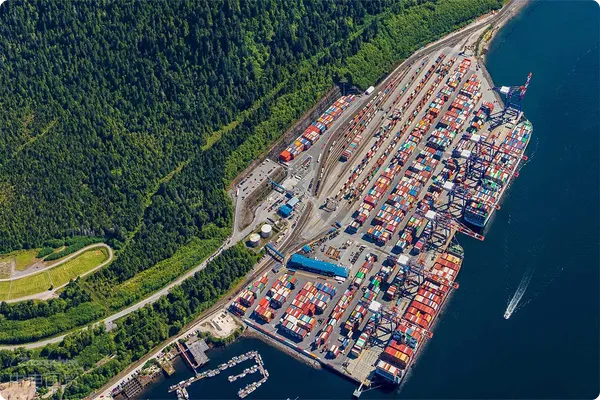- Shanghai Zhongshen International Trade Co., Ltd. - Two decades of trade agency expertise.
- Service Hotline: 139 1787 2118

As the worlds attention focused on the US presidential election on November 5, the major ports on the west coast of Canada - including the Port of Vancouver, Canadas largest container port, and the Port of Prince Rupert, the third - largest port, were temporarily closed due to a labor strike. In addition, a strike also recently occurred at the Port of Montreal, Canadas second - largest port, further exacerbating the tension in the trans - national supply chain.
This strike is particularly crucial for importers in the US Midwest, as the west - coast ports of Canada are important supply - chain nodes for Asian goods entering the US. A large amount of goods land at the Port of Vancouver and the Port of Prince Rupert and are then transported to the US via the cross - border railway between the US and Canada. According to data from the Greater Vancouver Board of Trade, about $800 million worth of trade passes through the west - coast ports every day, accounting for about 20% of US trade goods passing through Vancouver and Prince Rupert. Judging from past experience, even if the Canadian ports strike for only a few days, the impact on the US supply chain may last for months.
Local time on Monday, the container freight transportation at multiple ports on the west coast of Canada stopped immediately due to a labor strike. The trigger for this strike was that the leaders of the west - coast port union and industry representatives failed to reach a new labor agreement, leading to a large - scale strike by workers. The strike not only affected the Port of Vancouver and the Port of Prince Rupert but also spread to the Port of Montreal, causing a serious impact on the trans - national supply chain.
The US is Canadas largest trading partner. According to statistics from the US Department of Transportation, in the first half of this year, the cross - border railway trade between Canada and the US accounted for 14% of the total bilateral trade volume of $382.4 billion. US Census data shows that about $572 million worth of container trade arrives in the US from Canada every day. This round of strikes will have a significant impact on US imports, especially on industries that rely on Canadian ports, such as footwear, clothing, auto parts, chemicals, and timber.
Jena Santoro, Senior Manager of Smart Solutions at Everstream Analytics, said that disruptions at the Port of Vancouver will have the most significant impact on imported goods destined for the western US market. Vancouver is a key entry point for perishable foods such as dairy products, agricultural products, seafood, and manufactured goods such as auto parts, she said. Eric Byer, CEO of the Alliance for Chemical Distribution, pointed out that the closures of the Port of Vancouver and the Port of Prince Rupert are also expected to have a significant impact on many chemical importers, especially those transporting specific chemicals such as caustic soda, ethylene glycol, and sodium chlorate through the Port of Vancouver. These chemicals are used in many key areas such as water treatment, plastics, solvents, paper, pesticides, cleaning products, and de - icing products.
The potential impact of this strike is worrying. In July last year, the International Longshore and Warehouse Union of Canada went on a 13 - day strike, causing the transportation of goods to the US to take at least three months to return to normal. At the same time, the delay of railway containers extended from 39 days to 66 days. Paul Brashier, a logistics executive and Vice President of Global Supply Chain at ITS Logistics, said: The Port of Vancouver handles a large number ofMaritime Transportationcontainers that are transported to the US by rail. As was the case last year, this dispute needs to be resolved quickly because it will have a negative impact on many supply chains. These supply chains need goods required by the manufacturing industry and also need to restock for the peak holiday retail season.,
Alan Baer, CEO of an American oil company, warned that with the temporary shutdown of the trade gateways on the Canadian west coast, carriers may be forced to unload at the already strained US west coast, which will further increase the container dwell time and extend the overall freight time, leading to higher transportation costs and lower supply chain efficiency.
The main reason for this strike is that the union and the port management failed to reach an agreement on labor contracts and working conditions. Workers are demanding higher wages, an improved working environment, and better welfare benefits, while the port management emphasizes the need to control operating costs to cope with the uncertainties and competitive pressures of the global trade environment. The two sides failed to find a balance in the negotiations, ultimately leading to the occurrence of a large - scale strike.
In addition to the current strike, industry experts are also concerned about possible further labor actions in the future. With the increasing instability of the global economy, the calls for labor rights protection and improvement of working conditions are also rising. The strike actions of port workers may serve as a reference for other important ports, further affecting global trade liquidity.
Facing the huge challenges brought about by this strike, the relevant departments of Canada and the US are actively seeking solutions. The Canadian government said it is conducting emergency negotiations with union representatives and port management in an attempt to resume normal port operations as soon as possible. The US has called on Canada to fully support to ensure the stability of the supply chain and avoid a greater impact on the US economy and consumers.
At the same time, companies and supply chain managers are also actively adjusting their strategies to cope with possible transportation delays and cost increases. They are looking for alternative ports and transportation routes and optimizing inventory management to minimize the impact of the strike. However, these adjustments require time and resources, and it is difficult to completely offset the adverse effects of the strike in the short term.
Experts believe that the strike at Canadian ports is not only a labor - management dispute within a country but also a microcosm of the vulnerability of the global supply chain. With the continuous increase in international trade volume, the labor relations and operational efficiency of ports in various countries will directly affect the healthy operation of the global economy. Strengthening port management and labor - management communication and improving port automation and technological levels will be the key directions that the global port industry needs to focus on in the future.
Overall, the strike at the ports on the Canadian west coast has had a serious impact on the US import supply chain, especially on the eve of key holidays and peak sales seasons. This not only puts pressure on the US manufacturing and retail industries but also highlights the vulnerability of the global supply chain in the face of unexpected events. With the approaching general election, how to maintain the efficient operation of ports while protecting labor rights will be an urgent problem for the Canadian government and port management to solve.
Related Recommendations
? 2025. All Rights Reserved. 滬ICP備2023007705號-2  PSB Record: Shanghai No.31011502009912
PSB Record: Shanghai No.31011502009912









